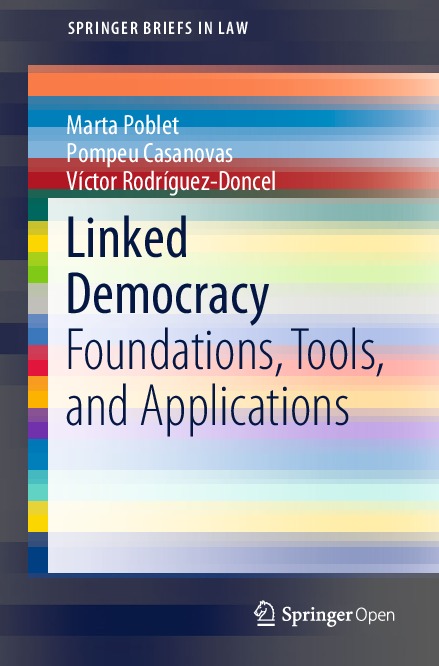File #2690: "2019_Book_LinkedDemocracy.pdf"
Text
1|Preface|6
1|Acknowledgements|9
2|In Chaps. 1–5|9
2|Figures in Chap. 4|9
1|Contents|10
1|List of Figures|12
1|List of Tables|13
1|1 Introduction to Linked Data|14
2|Abstract|14
2|1.1 Introduction|14
2|1.2 The World Wide Web as a Source of Data and Knowledge|15
3|1.2.1 Data, Information and Knowledge|15
3|1.2.2 The Web as a Source of Data|16
2|1.3 Linked Data|18
3|1.3.1 Universal Identifiers|18
3|1.3.2 Linked Data and RDF|19
3|1.3.3 Data Models, Ontologies and Ontology Design Patterns|23
3|1.3.4 Features of the Semantic Web|24
3|1.3.5 Rights in the Web of Data|27
3|1.3.6 Government of the Semantic Web|28
2|1.4 Government and the Web of Data|30
3|1.4.1 Open Government Data|30
3|1.4.2 Linked Open Government Data|30
3|1.4.3 eGovernment and eDemocracy|31
3|1.4.4 The Open Data Principles|33
3|1.4.5 Business Intelligence in the Public Sector|33
2|1.5 Conclusion|35
2|References|36
1|2 Deliberative and Epistemic Approaches to Democracy|39
2|Abstract|39
2|2.1 Introduction|39
2|2.2 Deliberative Approaches to Democracy|41
3|2.2.1 Deliberative Democracy in Action: Some Institutional Innovations|43
2|2.3 Epistemic Approaches to Democracy|46
3|2.3.1 Some Mechanisms of Aggregation in Epistemic Approaches|48
2|2.4 Knowledge, Cognition, and Democracy|53
2|2.5 Conclusion|56
2|References|57
1|3 Multilayered Linked Democracy|62
2|Abstract|62
2|3.1 Introduction|62
2|3.2 Knowledge Discovery: On the Shoulders of World 3 Explorers|64
2|3.3 Data, People, Institutional Arrangements|65
2|3.4 Connections and Connectors: A Multilayered Linked Democracy|67
3|3.4.1 Linked Open Data (LOD)|68
3|3.4.2 Linked Platforms|72
3|3.4.3 Linked Ecosystems|79
2|3.5 Conclusion|82
2|References|83
1|4 Towards a Linked Democracy Model|86
2|Abstract|86
2|4.1 Introduction|86
2|4.2 Properties of a Linked Democracy Model|88
2|4.3 Linked Democracy Ecosystems and Ostrom’s Core Design Principles|93
2|4.4 Conclusion|95
2|References|96
1|5 Legal Linked Data Ecosystems and the Rule of Law|98
2|Abstract|98
2|5.1 Introduction: The Rule of Law in a New Brave World|98
2|5.2 Governing Linked Democracy: Interoperable and Legal Governance|102
3|5.2.1 Semantic and Systemic Interoperability|102
3|5.2.2 Responsive, Smart, and Better Regulations|108
2|5.3 Governing Linked Democracy: A Socio-Cognitive Approach|112
3|5.3.1 A Regulatory Quadrant for the Rule of Law|112
3|5.3.2 Types of Legal Governance|115
2|5.4 Governing Linked Democracy: Socio-Legal Ecosystems|119
3|5.4.1 Socio-Legal Ecosystems|119
3|5.4.2 A Meta-Model for the Implementation of the Rule of Law|122
3|5.4.3 Semantic Web Regulatory Models (SWRM)|126
2|5.5 Conclusions and Future Work|128
2|References|130
1|6 Conclusion|138
1|Index|140
1|Acknowledgements|9
2|In Chaps. 1–5|9
2|Figures in Chap. 4|9
1|Contents|10
1|List of Figures|12
1|List of Tables|13
1|1 Introduction to Linked Data|14
2|Abstract|14
2|1.1 Introduction|14
2|1.2 The World Wide Web as a Source of Data and Knowledge|15
3|1.2.1 Data, Information and Knowledge|15
3|1.2.2 The Web as a Source of Data|16
2|1.3 Linked Data|18
3|1.3.1 Universal Identifiers|18
3|1.3.2 Linked Data and RDF|19
3|1.3.3 Data Models, Ontologies and Ontology Design Patterns|23
3|1.3.4 Features of the Semantic Web|24
3|1.3.5 Rights in the Web of Data|27
3|1.3.6 Government of the Semantic Web|28
2|1.4 Government and the Web of Data|30
3|1.4.1 Open Government Data|30
3|1.4.2 Linked Open Government Data|30
3|1.4.3 eGovernment and eDemocracy|31
3|1.4.4 The Open Data Principles|33
3|1.4.5 Business Intelligence in the Public Sector|33
2|1.5 Conclusion|35
2|References|36
1|2 Deliberative and Epistemic Approaches to Democracy|39
2|Abstract|39
2|2.1 Introduction|39
2|2.2 Deliberative Approaches to Democracy|41
3|2.2.1 Deliberative Democracy in Action: Some Institutional Innovations|43
2|2.3 Epistemic Approaches to Democracy|46
3|2.3.1 Some Mechanisms of Aggregation in Epistemic Approaches|48
2|2.4 Knowledge, Cognition, and Democracy|53
2|2.5 Conclusion|56
2|References|57
1|3 Multilayered Linked Democracy|62
2|Abstract|62
2|3.1 Introduction|62
2|3.2 Knowledge Discovery: On the Shoulders of World 3 Explorers|64
2|3.3 Data, People, Institutional Arrangements|65
2|3.4 Connections and Connectors: A Multilayered Linked Democracy|67
3|3.4.1 Linked Open Data (LOD)|68
3|3.4.2 Linked Platforms|72
3|3.4.3 Linked Ecosystems|79
2|3.5 Conclusion|82
2|References|83
1|4 Towards a Linked Democracy Model|86
2|Abstract|86
2|4.1 Introduction|86
2|4.2 Properties of a Linked Democracy Model|88
2|4.3 Linked Democracy Ecosystems and Ostrom’s Core Design Principles|93
2|4.4 Conclusion|95
2|References|96
1|5 Legal Linked Data Ecosystems and the Rule of Law|98
2|Abstract|98
2|5.1 Introduction: The Rule of Law in a New Brave World|98
2|5.2 Governing Linked Democracy: Interoperable and Legal Governance|102
3|5.2.1 Semantic and Systemic Interoperability|102
3|5.2.2 Responsive, Smart, and Better Regulations|108
2|5.3 Governing Linked Democracy: A Socio-Cognitive Approach|112
3|5.3.1 A Regulatory Quadrant for the Rule of Law|112
3|5.3.2 Types of Legal Governance|115
2|5.4 Governing Linked Democracy: Socio-Legal Ecosystems|119
3|5.4.1 Socio-Legal Ecosystems|119
3|5.4.2 A Meta-Model for the Implementation of the Rule of Law|122
3|5.4.3 Semantic Web Regulatory Models (SWRM)|126
2|5.5 Conclusions and Future Work|128
2|References|130
1|6 Conclusion|138
1|Index|140

